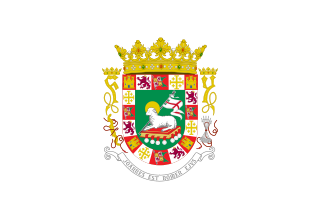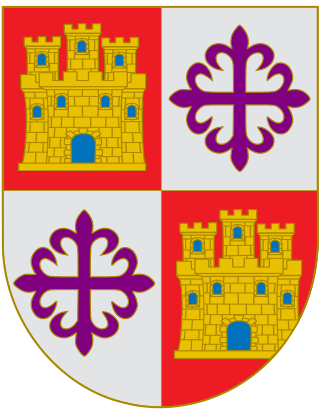Related Research Articles

Juan Ponce de León was a Spanish explorer and conquistador known for leading the first official European expedition to Puerto Rico in 1508 and Florida in 1513. He was born in Santervás de Campos, Valladolid, Spain, in 1474. Though little is known about his family, he was of noble birth and served in the Spanish military from a young age. He first came to the Americas as a "gentleman volunteer" with Christopher Columbus's second expedition in 1493.

Conquistadors or conquistadores were the explorer-soldiers of the Spanish and Portuguese Empires of the 15th and 16th centuries. During the Age of Discovery, conquistadors sailed beyond Europe to the Americas, Oceania, Africa, and Asia, colonizing and opening trade routes. They brought much of the new world under the dominion of Spain and Portugal.
Juan Ponce de León II (1524–1591) was a Spanish official and an acting governor of Puerto Rico. He was the first acting governor to be born on the island.

The governor of Puerto Rico is the head of government of the Commonwealth of Puerto Rico, and commander-in-chief of the Puerto Rico National Guard.

Jumacao a.k.a. Jumaca was the Taíno Cacique (Chief) of the area in Puerto Rico named after him.

Aracibo was a Taíno Cacique in Puerto Rico who governed the area which is now named after him.

The Alano Español or Spanish Bulldog is a Spanish breed of medium to large sized dog of alaunt-bulldog type. It has at various times been used as a war dog, for bullfighting, for the management of cattle, for hunting and as a guard dog.

Agüeybaná II, born Güeybaná and also known as Agüeybaná El Bravo, was one of the two principal and most powerful caciques of the Taíno people in "Borikén" when the Spaniards first arrived in Puerto Rico on November 19, 1493. Agüeybaná II led the Taínos of Puerto Rico in the Battle of Yagüecas, also known as the "Taíno rebellion of 1511" against Juan Ponce de León and the Spanish Conquistadors.

Caparra is an archaeological site in the municipality of Guaynabo, Puerto Rico. It was declared a U.S. National Historic Landmark in 1994. The site contains the remains of the first Spanish capital of the island, settled in 1508 and abandoned in 1521. It represents the oldest known European settlement on United States territory.

The Museo de la Historia de Ponce is a local history museum located in the historic Casa Salazar-Candal in the city of Ponce, Puerto Rico. The museum depicts the city's ecology, economy, architecture, government, and elements of daily life. It seeks to promote the research, conservation, and dissemination of the historic heritage of Ponce and Puerto Rico.
Juan Ponce de León y Loayza was the son of Juan Ponce de León II, the interim Spanish governor of Puerto Rico in 1579. His mother was Isabel de Loayza born in Villa Talavera de la Reina, Toledo, Spain, the daughter of Governor Iñigo López de Cervantes y Loayza. The city of Ponce, Puerto Rico, was named after Juan Ponce de León y Loayza.
Nicolás Suárez Ponce de León was the accountant for the Royal Treasury of Spanish Florida from 1630 until his death in 1651, and from 1631 to 1633 served as acting co-governor of the colony with Eugenio de Espinosa, when Governor Andrés Rodríguez de Villegas died in office, and also for a few months in 1651.
The Spanish and Taíno War of San Juan–Borikén, also known as the Taíno Rebellion of 1511, was the first major conflict to take place in modern-day Puerto Rico after the arrival of the Spaniards on November 19, 1493.

Enrique Enríquez the Younger was a nobleman of Castile, son of Enrique Enríquez the Elder. He was lord of Villalba de los Barros, Nogales, Almendral, La Parra, Begíjar and other towns. He was Adelantado Mayor of the border of Andalusia, chief justice of the King's House, Chief of the forces of the bishopric and Kingdom of Jaén, Mayor of Seville and Knight of the Band.
The following is a timeline of the history of the city of Ponce, Puerto Rico.

San Juan Bay is the bay and main inlet adjacent to Old San Juan in northeastern Puerto Rico. It is about 3.5 miles (5.6 km) in length, the largest body of water in an estuary of about 97 square miles (250 km2) of channels, inlets and eight interconnected lagoons. The San Juan Bay is home to the island's busiest harbor and its history dates back to at least 1508.

Agüeybaná El Bravo is a stone statue to the memory of Agüeybaná II, is 1 Taíno cacique in Puerto Rico, for his bravery in fighting the Spanish invaders during the sixteenth century. It is located at Plaza Agüeybaná El Bravo in Barrio Playa, at the southeast corner of the intersection of PR-2/Ponce Bypass and Avenida Hostos, just south of sector Caracoles in Ponce, Puerto Rico.
SS Ponce De Leon was a Liberty ship built in the United States during World War II. She was named after Ponce De Leon, a Spanish explorer and conquistador known for leading the first official European expedition to Florida and the first governor of Puerto Rico.

Ochoa Álvarez de Isásaga was born around 1470 in Villafranca de Ordizia, Spain. "Ochoa" is a Basque patronymic name originally given in Medieval Spain meaning "the wolf."
References
Citations
- 1 2 Cummins (2003), p. 19
- ↑ Derr (2013), p. 43
- 1 2 3 Slavicek (2009), p. 65
- ↑ Cummins (2003), p. 18
- ↑ "Selección de Leyendas puertorriqueñas - Becerrillo". University of Florida Digital Library (in Spanish).
- 1 2 3 4 Coren (2002), p. 77
- 1 2 Coren (2002), p. 78
- ↑ Coren (2002), p. 79
- ↑ Kistler (2011), p. 11
- ↑ Derr (2013), p. 44
- ↑ Cummins (2003), p. 20
Bibliography
- Coren, Stanley (2002), The Pawprints of History: Dogs in the Course of Human Events, Simon and Schuster, ISBN 978-0-7432-2770-4
- Cummins, Bryan D. (2003), Colonel Richardson's Airedales: The Making of the British War Dog School, 1900-1918, Dog Training Press, ISBN 978-1-55059-248-1
- Derr, Mark (2013), A Dog's History of America: How Our Best Friend Explored, Conquered, and Settled a Continent, The Overlook Press, ISBN 978-1-4683-0910-2
- Kistler, John M. (2011), Animals in the Military: From Hannibal's Elephants to the Dolphins of the U.S. Navy, ABC-CLIO, ISBN 978-1-59884-347-7
- Slavicek, Louise Chipley (2009), Juan Ponce de León, Infobase Publishing, ISBN 978-1-4381-0684-7